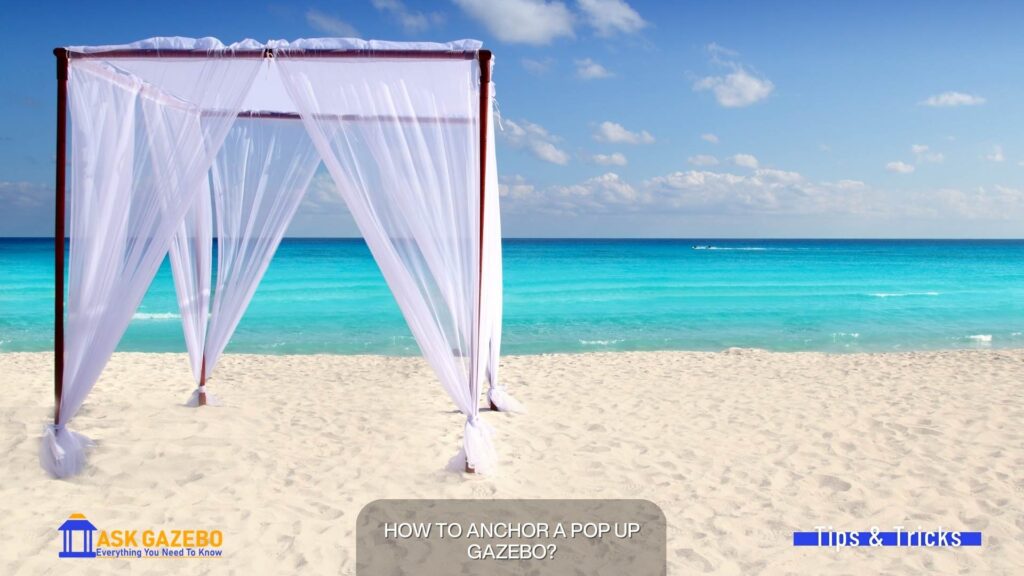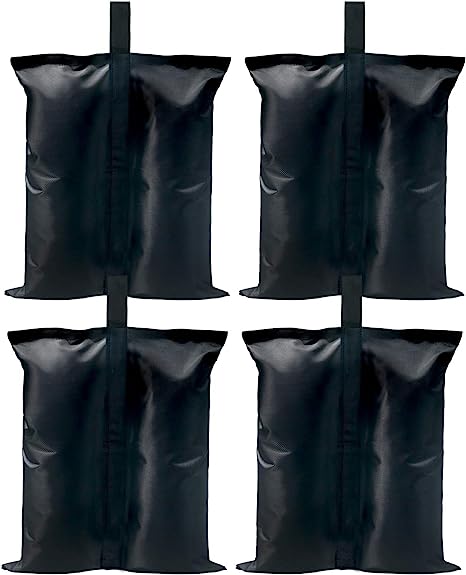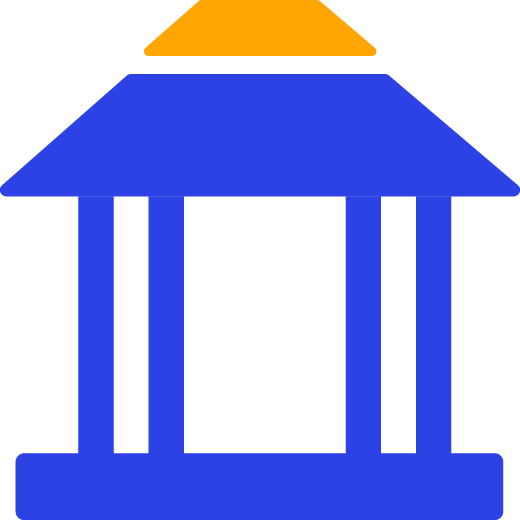A pop-up gazebo, also known as an instant or portable gazebo, is typically lightweight and easy to assemble gazebo.
But, for certain conditions, anchoring a pop up gazebo can be a challenge. It is why learning how to anchor a popup gazebo is worth it.
We are going to talk about the different things to think about when anchoring a pop-up gazebo, the different types of anchors you can use, and a step-by-step guide on how to anchor a pop-up gazebo safely and securely.
So, stay with us.
Factors to Consider When Anchoring a Pop-Up Gazebo
When you anchor a pop-up gazebo, there are a few things you need to think about to make sure it stays safe and stable. These considerations will determine how you will anchor your portable gazebo.
Type of Ground: The ground on which you want to anchor your gazebo is highly important. Why? It will determine the next steps.
For example, if the ground is hard, like concrete, you can add some weight with gazebo legs. But you can use ground stakes if the ground is soft, like grass.


Wind Conditions: The speed and direction of the wind can affect how stable the gazebo is, so it’s important to know how the weather is right now and if it’s going to change.
If there is a lot of wind, you have to add more anchors or weight to keep the gazebo stable.
Size of the Gazebo: Larger gazebos will need more anchors and support because they will be more likely to move in the wind and put more pressure on the anchors.
Most of the time, the manufacturer’s instructions will say how many anchors you need for the gazebo you have purchased.
Purpose of the Gazebo Last but not least, consider how you intend to use your gazebo. A solid anchoring system is required if it will be used for a permanent or semi-permanent structure, such as a garden shade.
On the other hand, if it is only being used for a one-time event, then you can go for the light anchoring technique.


Step-by-Step Guide to Anchoring a Pop-Up Gazebo
Anchoring a pop-up gazebo is a key step in ensuring it stays in place and is safe.
Preparation:
- Choose the right anchor type: Choose the right anchors based on the type of ground, the amount of wind, and the size of the gazebo. It could be tent stakes, sandbags, water barrels, or weight bags.
- Collect the things you need: Make sure you have everything you need, like tent stakes, weight bags, and, if needed, a hammer or mallet.
- Read the instructions from the maker: Read the instructions that came with your pop-up gazebo to find out how many and where to put the anchors.
By following these steps during the planning phase, you can ensure you have all the tools and information you need to anchor your pop-up gazebo securely.
Setting Up the Gazebo:
After you’ve done everything, you need to prepare the gazebo. Here’s what you need to do:
- Pick a flat area: Choose a flat spot for the gazebo and clear the ground of anything in the way. Then, Spread the gazebo on it to make it’s anchoring smooth.
- Put together the gazebo: Make sure the gazebo is centered and level by following the instructions from the manufacturer.
- Attach guying: Guying is a kind of rope used to give the gazebo more support and stability. It will let you tightly fit the pop-up gazebo with the anchors.
How To Anchor A Pop-Up Canopy or Gazebo?
Anchoring a pop-up gazebo is the last step in setting it up. It keeps it from falling over in windy weather.
Depending on the type of anchors you are using, here are the steps to take:
Ground stakes or pegs: Suitable for soft surfaces like grass, dirt, or sand.
Drive stakes or pegs through the gazebo’s leg holes or loops provided at the base of each leg. You can create strong anchoring by driving the stakes through the leg holes into the ground.
It’s important to make sure the stakes or pegs are fully inserted into the ground and are tightly secured to the gazebo legs to ensure maximum stability.
Alternatively, use ropes or straps attached to the gazebo’s frame, and secure them to the ground with stakes or pegs at an angle away from the gazebo. It creates tension and helps to stabilize the structure.
Weight plates or bags: Ideal for hard surfaces like concrete, asphalt, or wooden decks where stakes cannot be used.
Place weight plates or bags around the gazebo’s legs or corners.
Ensure that the weights are heavy enough to provide adequate stability for the gazebo.
Guy ropes and anchor points: Attach guy ropes or straps to the upper corners or frame of the gazebo.
Secure the other end of the ropes to ground stakes, screw-in ground anchors, or weights. Adjust the tension of the ropes to keep the gazebo stable and taut.
Leg weights or sandbags: Wrap specially designed leg weights or sandbags around the gazebo legs.
These weights often use Velcro straps or chains to secure them in place.


This kit provides ample weight to keep your gazebo securely anchored even in the high winds. The sandbags are also easy to fill and empty. We highly recommend this anchoring kit for almost every type of gazebo.
View On
Leg weights add stability to the gazebo without taking up much space.
Always follow the manufacturer’s recommendations for anchoring your specific pop-up gazebo model.
Be prepared to add extra anchoring in severe weather conditions, as pop-up gazebos are not designed to withstand extreme wind, rain, or snow.


Subscribe For More Gazebo Videos!
Ask Gazebo
⚠️ Safety Precautions When Anchoring a Pop-Up Gazebo:
Even though anchoring a pop-up gazebo isn’t too hard, it’s important to take safety precautions. Here are a few safety tips to keep in mind:
Follow the manufacturer’s instructions: It will ensure the gazebo is securely fastened and the anchors are placed correctly. The manufacturer’s instructions will also inform you how many anchors you need based on the size and weight of the gazebo.
Use enough anchors: Ensure you use enough anchors to keep the gazebo in place. If there aren’t enough anchors, the gazebo might fall over when it’s windy.
Always check the anchors: Check them often to ensure they are still in place securely, and make changes as needed. Anchors can become loose or fall off over time, so it’s important to check them often to make sure the gazebo stays stable and safe.
Avoid over-tightening: When putting on guying or anchors, it’s important not to tighten them too much because that could damage the gazebo or cause too much tension.
FAQs
Here are some questions and answers about how to anchor a pop-up gazebo:
Can I put a pop-up gazebo on a hard surface?
Yes, you can anchor a pop-up gazebo to a hard surface like concrete, but you might need to use weight bags or sandbags instead of tent stakes.
Can I tie down a pop-up gazebo when it’s windy?
Yes, you can anchor a pop-up gazebo when it’s windy, but you need to use enough anchors to make sure it’s stable and safe. If the wind is very strong, you may need to remove the gazebo or add more anchors to keep it in place. Learn How To Secure A Gazebo From Wind.
How often should I check my pop-up gazebo’s anchors?
It is a good idea to regularly check the anchors of your pop-up gazebo to ensure they are still securely in place. Anchors can become loose or fall off over time, so checking them often will help make sure the gazebo stays stable and safe.
What do I do if my pop-up gazebo falls over when it’s windy?
If your pop-up gazebo falls down in the wind, check to make sure no one is hurt. Then, carefully take back the gazebo and all of its parts and look for any damage.
If the gazebo is broken, it might need to be fixed or bought a new one. If it isn’t broken, properly anchor it by using the right number and type of anchors for the size and amount of wind.
Conclusion:
Anchoring a popup gazebo is not as difficult as it looks like. But making sure it anchors properly is important.
We have shared some methods to anchor a popup gazebo above. All this will help you anchor your portable gazebo with ease.








